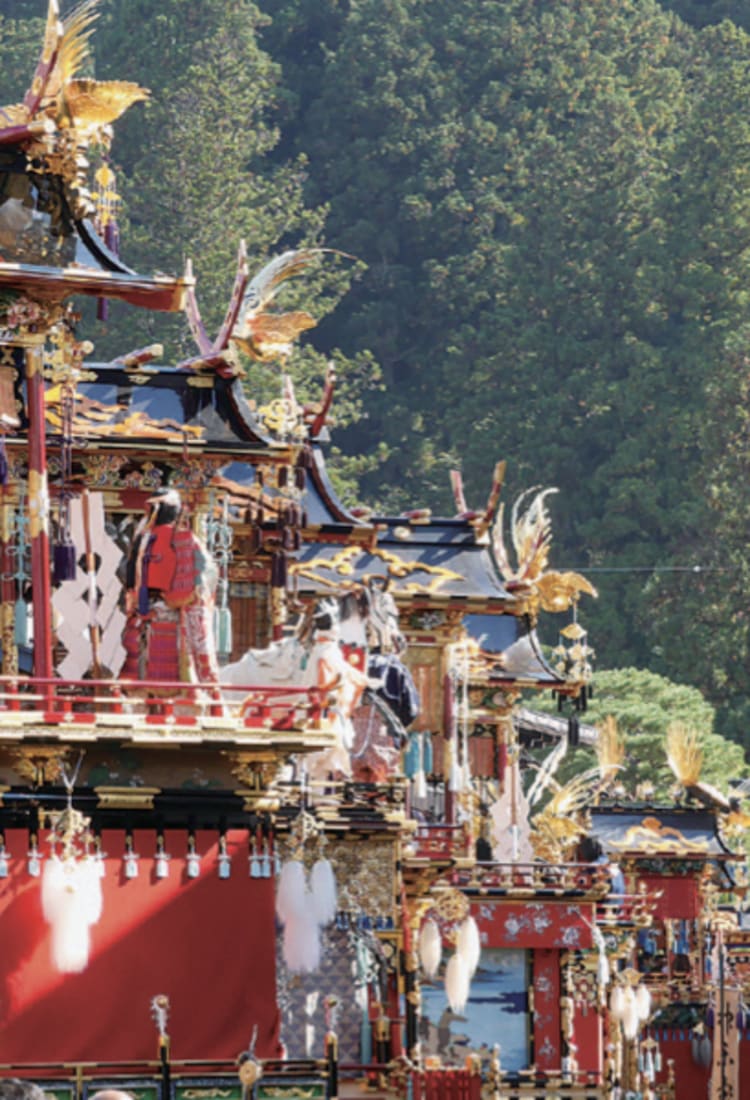
The beautiful Takayama Festival, with its splendid floats
The beautiful Takayama Festival, with its splendid floats
Getting the best view of the 11 floats, centerpiece of the Takayama Festival
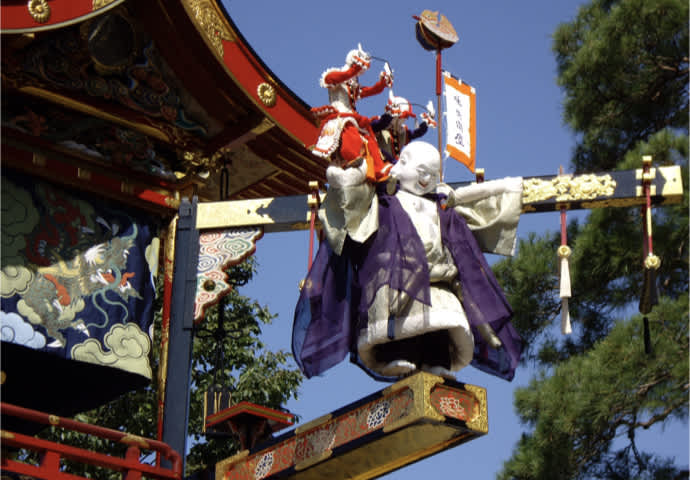
Takayama Festival is actually two festivals that take place annually in the city of Takayama, in Gifu Prefecture: the Sanno Festival, in the spring, which is the festival of the Hie Shrine, and the Hachiman Festival, in the autumn, which is the festival of the Sakurayama Hachimangu Shrine. The centerpiece of both events is a collection of splendid yatai, of which 12 feature in the spring festival and 11 in the autumn festival, dazzling the crowds of onlookers with their colorful and intricate decorations.
The autumn festival takes place on October 9 and 10 each year. A detailed schedule is published around one month before the festival, in pamphlets and on the Takayama City website, but if you want to view the yatai at leisure, you should start with a visit to the Sakurayama Hachimangu Shrine.
The yatai hikizoroe (gathering of yatai), in the grounds of the shrine and on the avenue leading to its front gate, is a unique opportunity to see all 11 yatai together, as they are normally stored at different locations around the city. It allows visitors to examine the decorations close up, and admire the carpentry, lacquerwork, gilding, woodcarving and metalwork skills that have gone into their creation.
You can also watch performances by mechanical puppets (karakuri ningyo) mounted on the yatai. The puppets of the Hoteitai yatai perform twice a day during the two days of the festival. The show (karakuri-hono) involves two puppets dressed as Chinese children (karako ningyo), a boy and a girl, performing circles on five trapeze bars, moving from one to the next, before ending up on the shoulders of a puppet of Hotei, god of good fortune.
Surprisingly, the puppets are not automatons, but are controlled by nine highly skilled puppeteers known as ayakata, using a total of 36 silk cords. The spectators cheer each time one of the child puppets successfully moves to the next trapeze, and the excitement of the festival reaches a peak. The grounds of the shrine are usually crowded with spectators, so you will need to arrive at least 30 minutes before the start of the performance to be sure of a good view.
The beauty of the traditional costumes and yatai by night is a key attraction of the Takayama Festival
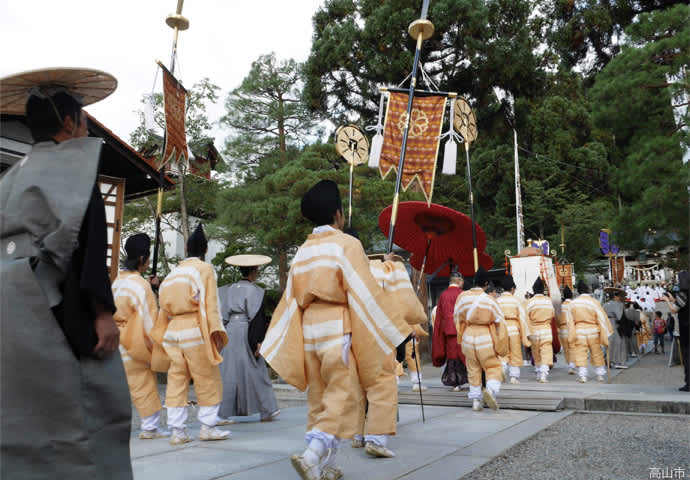
You can enjoy the autumn festival not just at the Sakurayama Hachimangu Shrine, but in the streets of Takayama. The procession of four wheeled yatai (yatai hikimawashi), takes place only during the autumn festival, on the afternoon of October 9. The beauty of the yatai, set off by backdrop of Takayama’s historic district, is an enchanting spectacle.
Another festival must-see is the Goshinko procession, in which gods usually worshiped at permanent shrines parade through the streets in portable shrines, followed by a procession of many hundreds of people. The costumes worn by the participants are a key attraction. The Tokeiraku performers, who wear flat straw hats and sound bells and drums to an accompaniment of ancient gagaku music, and the parade marshals (keigo) with their broad-shouldered kamishimo over-garments, are among the finest sights of the festival. The Goshinko procession takes place on both October 9 and 10.
For the Yoimatsuri (evening festival), which starts at 6pm on October 9, 11 yatai, each lit by around 100 lanterns, are brought out into the streets of Takayama. Though splendid by day, the yatai take on a special, almost magical beauty by night.
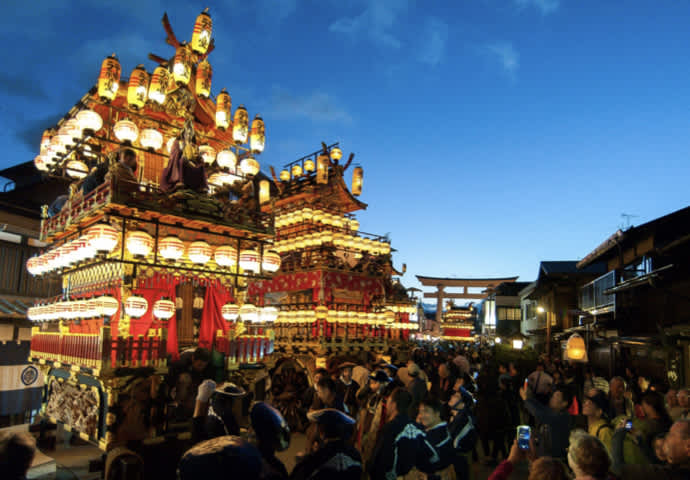
Enjoy a rich variety of tourist attractions in historic Takayama

Outside the festival period, a number of yatai are on permanent display at the Takayama Matsuri Yatai Kaikan, situated in the grounds of the Sakurayama Hachimangu Shrine. If your schedule allows you to stroll around the city about a week before the festival, you can observe the work of attaching the decorations to the yatai, a process known as yatai yawai. It’s a rare opportunity to see how the yatai are put together, and will enhance your enjoyment of the festival itself.
The historic district of Takayama preserves the old townscape. It serves as a backdrop for the yatai procession and the Yoimatsuri during the autumn festival, but is also pleasant just to stroll around. Takayama was founded in the late 16th century as a castle town, and even now retains a flavor of the time, with its grid street plan. Part of the city has been designated an Important Preservation District for Groups of Traditional Buildings.
One spot well worth a visit, and where the history of Takayama is particularly evident, is the Takayama Jinya, which served as government offices from the end of the 17th century. This historically important structure is the only one of its kind in Japan to remain unchanged since its days as a government building.

Jinyamae Asaichi (morning market) is held every morning close by the Takayama Jinya. Here you can talk with local farmers while enjoying the delights of the changing seasons, centering on locally grown fresh fruit, vegetables and flowers. Together with the Miyagawa Asaichi, held along the banks, it is a great opportunity to meet local people.
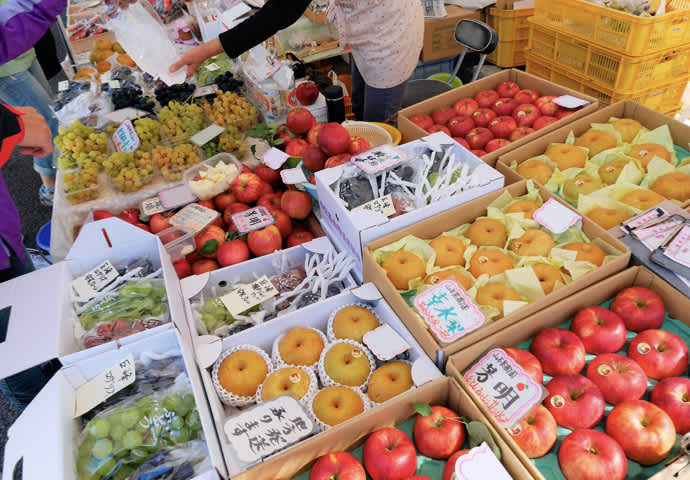
In recent years, many cultural experience programs aimed at foreign visitors have been developed. Among the most popular are walking around the historic streets of Takayama dressed in a kimono, and trying your hand at making Sarubobo dolls, a popular local souvenir. More information to help you plan your visit can be found on the English version of the Hida Takayama Tourist Information website.
For more information, visit Hida Takayama Tourist Information at




















































